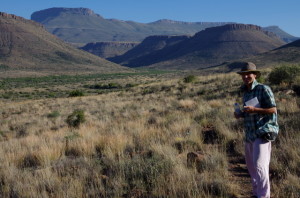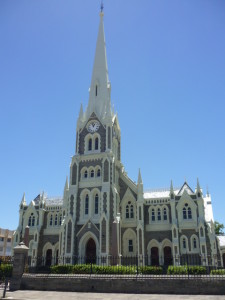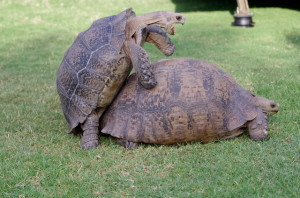After a quick visit through the Northern Cape, it was time to head south toward the coast. To do so, we had to pass through the southernmost edge of the desert we have been seemingly traveling through forever. This piece of arid land, situated at the northernmost sections of the Western and Eastern Capes, is famously called “the Karoo” (not to be confused with the “Little Karoo” further west). It is a distinct section of the larger desert region it is part of, characterized by semi-arid bushes and scrubs, large tabletop mountains, ancient reptilian fossils, and a distinct Karoo town culture.

I liked driving through the Karoo. I could see the landscape slowly changing, becoming more hilly and just a wee-bit more lush. I could even feel a cool breeze from time to time. The towns, too, were different. They were certainly bigger, less provincial-feeling, and with more well-preserved historical buildings due to the greater amount of tourism, I suppose. Perhaps they didn’t have the friendliness or the small-town charm of the Northern Cape towns, but aesthetically and culturally, they appealed to me more.
Bruno and I didn’t visit the towns extensively, however, for we were here for the National Parks. South Africa has a plethora of National Parks scattered throughout the country, all with clean, well-equipped campsites. We plan to visit many such sites during our time in South Africa, and we started with the Karoo National Park, just outside of Beaufort West.
 Karoo National Park isn’t well-stocked with African animals, like some of its more famous brothers (like Kruger National park, which we hope to visit in April). It has only one lion, and none of the other Big 5 animals (rhino, elephant, leopard, African buffalo). What it does boast – and indeed, what it aims to preserve – is the quintessential Karoo landscape, filled with its birds, shrubs, mountains and fossils. This means there is a bird hide, where you can sit and watch birds at a lagoon from inside an enclosed wooden hut. It also means that there are guided 5km walks early each morning up the mountains to catch a 360 degree aerial view of the Karoo. There is a 1km bush walk, called the “Bossie Trail,” that comes with an informative pamphlet describing different Karoo plants, like the Hairy Nipple and the Scorpion Bush. And there is a fossil trail, featuring fossils of ancient reptiles that lived in the Karoo over 250 million years ago, when Pangaea was still in one piece! To the layman, these creatures resemble dinosaurs, but in fact, they lived at least 50 million years earlier!
Karoo National Park isn’t well-stocked with African animals, like some of its more famous brothers (like Kruger National park, which we hope to visit in April). It has only one lion, and none of the other Big 5 animals (rhino, elephant, leopard, African buffalo). What it does boast – and indeed, what it aims to preserve – is the quintessential Karoo landscape, filled with its birds, shrubs, mountains and fossils. This means there is a bird hide, where you can sit and watch birds at a lagoon from inside an enclosed wooden hut. It also means that there are guided 5km walks early each morning up the mountains to catch a 360 degree aerial view of the Karoo. There is a 1km bush walk, called the “Bossie Trail,” that comes with an informative pamphlet describing different Karoo plants, like the Hairy Nipple and the Scorpion Bush. And there is a fossil trail, featuring fossils of ancient reptiles that lived in the Karoo over 250 million years ago, when Pangaea was still in one piece! To the layman, these creatures resemble dinosaurs, but in fact, they lived at least 50 million years earlier! Bruno and I spent 5 days in the Karoo NP, which is as long as we’d spent in the entire Northern Cape! Officially, we needed the R&R after covering so many kilometers in so little time. But secretly, I think it was because of the animals at the campsite. For five days, we were massively entertained by birds, field mice, and especially the five tortoises. You’re not supposed to feed animals in national parks – or anywhere, really – and I understand the purpose of this policy. But realistically, this is difficult to obey when it comes to the little campsite creatures, and Bruno and I have been disobeying this rule consistently since we began our journey together. I hope no one from the SANParks office reads this entry, because I admit, wholeheartedly, to feeding the birds and mice. I couldn’t help myself – I felt like their friend at these moments, and the entertainment they provided was better than television! To watch the bird babies chirp and convulse their entire bodies as a plea for food, and to watch the parents faithfully provide; to see the mice chase each other over tiny crumbs of food, hopping straight into the air and scurrying around in circles; to see the hierarchy of eating in this little community – this was too interesting and entertaining to forego.
Bruno and I spent 5 days in the Karoo NP, which is as long as we’d spent in the entire Northern Cape! Officially, we needed the R&R after covering so many kilometers in so little time. But secretly, I think it was because of the animals at the campsite. For five days, we were massively entertained by birds, field mice, and especially the five tortoises. You’re not supposed to feed animals in national parks – or anywhere, really – and I understand the purpose of this policy. But realistically, this is difficult to obey when it comes to the little campsite creatures, and Bruno and I have been disobeying this rule consistently since we began our journey together. I hope no one from the SANParks office reads this entry, because I admit, wholeheartedly, to feeding the birds and mice. I couldn’t help myself – I felt like their friend at these moments, and the entertainment they provided was better than television! To watch the bird babies chirp and convulse their entire bodies as a plea for food, and to watch the parents faithfully provide; to see the mice chase each other over tiny crumbs of food, hopping straight into the air and scurrying around in circles; to see the hierarchy of eating in this little community – this was too interesting and entertaining to forego. And the tortoises. Each afternoon, we would hear a sound, like a grunt, at regular intervals, and we would know that HE was at it again. That is, the male turtle, er, taking pleasure in his female companion. Once again, I wholeheartedly admit to watching this sexual act each time I heard the grunt. I watched it from so close that I could see the male tortoise’s pointy penis thrust into the back of the female, who would advance a few inches, thereby forcing the male to move forward and thrust inward again. The female would chomp on grass all the while, scarcely aware that she was being penetrated, and when the act reached its peak with a slightly louder and longer grunt, the male would disembark, walk off to another section of grass and neither would give the other a second glance. Romantic!
And the tortoises. Each afternoon, we would hear a sound, like a grunt, at regular intervals, and we would know that HE was at it again. That is, the male turtle, er, taking pleasure in his female companion. Once again, I wholeheartedly admit to watching this sexual act each time I heard the grunt. I watched it from so close that I could see the male tortoise’s pointy penis thrust into the back of the female, who would advance a few inches, thereby forcing the male to move forward and thrust inward again. The female would chomp on grass all the while, scarcely aware that she was being penetrated, and when the act reached its peak with a slightly louder and longer grunt, the male would disembark, walk off to another section of grass and neither would give the other a second glance. Romantic! Please do not judge my intimate examination of tortoise sex. The tortoises certainly didn’t. And besides, I learned something from my spying. I learned that the only way to tell the difference between the male and female tortoise is by the bottom of their shell – the female’s is flat, while the male’s is concave, allowing him to properly mount and enter the female. Spying in the name of learning is exactly the point of a National Park, right?
 Unfortunately, the heat followed us from the Namib Desert to the Karoo, as we experienced temperatures of 43 degrees, when the all-time maximum in January was previously 41 degrees! After trying to wait the heat out, we decided it was time to move on. So we drove 200km east, to the Camdeboo National Park, outside Graff-Rienet. Once again, Camdeboo NP isn’t famously recognized for its big game. It does have 70 buffalo, but they hid from us the entire two days we were at the park. We did get to see a few new antelope – the minuscule grysbok and the striking blesbok – and we did spend a bit of time at the dam watching African Fish Eagles, Black-headed Herons, Cattle Egrets, and Black-winged Stilts. (Can you tell I have an animal guide book and that I’m amusing myself at trying to identify each species I see?)
Unfortunately, the heat followed us from the Namib Desert to the Karoo, as we experienced temperatures of 43 degrees, when the all-time maximum in January was previously 41 degrees! After trying to wait the heat out, we decided it was time to move on. So we drove 200km east, to the Camdeboo National Park, outside Graff-Rienet. Once again, Camdeboo NP isn’t famously recognized for its big game. It does have 70 buffalo, but they hid from us the entire two days we were at the park. We did get to see a few new antelope – the minuscule grysbok and the striking blesbok – and we did spend a bit of time at the dam watching African Fish Eagles, Black-headed Herons, Cattle Egrets, and Black-winged Stilts. (Can you tell I have an animal guide book and that I’m amusing myself at trying to identify each species I see?)The highlight of Camdeboo NP is, like Karoo NP, a natural landscape – here, the breathtaking Valley of Desolation. The VoD is a deep double crevice in a red-rocked mountain overlooking the Karoo landscape. From the side, the valley is shaped like a “W”, and if you hike up to the final point of the W, you can look down into the first valley. Once again, I admit to doing something probably illegal – I climbed over the ledge and sat on a massive boulder on the other side. I wanted a better view! And, boy, did I get one! As I looked over the edge of the boulder, down into the rocky valley filled with large, green trees, I realized how quickly I could plunge to my death. Holding on a bit tighter, I took in the vast Karoo landscape beyond. I listened to the echo of the bird calls below, and Bruno and I added our own. I watched a few paragliders and a lone hanglider drift and soar and twirl over the valley. And I contemplated the enormity of the universe and my small, small place in it. How lucky I am, in my short time on earth, to be able to be part of such big things.

We are now in Somerset East, which means we have left the Karoo, and the incredibly large, incredibly challenging, desert. Gone are the hot, dry days, the colorless landscape, the barren earth, and the kilometers devoid of civilization. The Bosberg Mountains loom behind this non-Karoo town, a brilliant shade of green. We are camped beside the Great Fish River, and there are mosquitoes. Clouds are gathering over the mountains, and they warn of an impending storm. It has become cold, damp, and windy, and I am contemplating cooking dinner inside the camper.
Tomorrow we are on the road again. Should we continue further south, through the lush, foresty mountains and to the Wild Coast, or back into the warmth and dryness of the Karoo?



megs - Love the post Brittany!!! Your picture of the tortoises was just so intriguing I had to read on! HAHA!
Hope you’re surviving the heat while we survive the cold!
XXOO